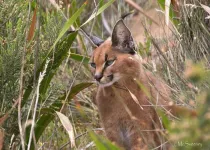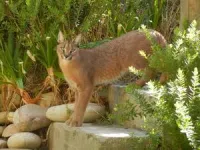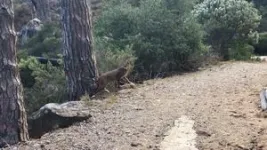(Press-News.org) Facebook and Instagram can boost wildlife conservation efforts through public awareness and engagement, according to a study published in the peer-reviewed journal Environmental Communication.
The findings based on the caracal – a wild cat native to Africa with distinctive tufted ears – demonstrate how social media can harness support for the predators, which some farmers shoot and poison.
Results show that the mammal’s similarity to a domestic feline has attracted thousands of followers to internet feeds about caracal conservation. The researchers suggest this online appeal is linked to the phenomenon where cat images, videos, and memes go viral.
They highlight how ‘charismatic’ smaller mammals such as the caracal can be used as a ‘flagship species’ to communicate the aims of scientific research in rapidly urbanizing areas.
“Using an aesthetic species such as the caracal is an effective way to capture public attention to communicate the importance of conserving urban wildlife,” say Drs Gabriella Leighton and Laurel Serieys from the University of Cape Town.
“These findings highlight the use of smaller carnivores as flagship conservation species for rapidly urbanizing areas.
“This paper contributes to our understanding of the various ways in which the public can participate in science. It shows how charismatic species can contribute to conservation and public awareness of biodiversity in urban areas.
“The research demonstrates how a public interest in urban ecology and the global phenomenon of ‘cats on the internet’…can be harnessed to leverage conservation action.”
Better public engagement is key to achieving conservation goals, especially in biodiversity hotspots. A range of species are both unique to these regions and endangered, and these threatened areas are increasingly urbanized and understudied.
Cape Town is located within a biodiversity hotspot and home to the caracal, an elusive mammal regarded as vermin by livestock farmers elsewhere in South Africa.
The Urban Caracal Project (UCP) was set up in December 2014 to explore caracal ecology and social media was used to influence awareness and perceptions towards caracal conservation in an urban setting. The UCP is run by a research team hosted by the Institute for Communities and Wildlife in Africa at the University of Cape Town.
The project communicates its works in several ways including via a website but most interactions are via social media.
The study authors used Google Trends to assess the global popularity of caracals from 2004 to present day, before and after UCP was set up. They compared the interest with that in a similar African wildcat – the serval.
They also used recent Facebook and Instagram data to analyze all material UCP had posted online and looked at direct public engagement such as reported caracal sightings, rescues, and finds of the wildcats dead.
Results showed a doubling in search interest in the term ‘caracal’ since UCP was launched. This represents a 91% increase compared to that for ‘servals’ which rose by 76% in the same period. The authors say this suggests the project has helped raise awareness of the caracal as a species worldwide.
Other findings include the fact the project now has more than 16,800 Facebook followers and more than 7,300 on Instagram, figures that represent ‘micro-influencer’ status. Most are from people in South Africa but also include those in the UK, India, and the US.
The UCP has received traffic and interactions from accounts linked to the ‘Big Floppa’ meme inspired by an overweight caracal born in a cattery in Kyiv, Ukraine. Again, this links to the popularity of 'cats on the internet’ according to the authors.
The authors also say caracal deaths reported by the public – often via WhatsApp and social media – allow them to perform post-mortems. They can then assess threats to the caracal population and roadkill patterns.
Tissue analysis has revealed the animals are exposed to pollutants and pesticides, such as rat poison. Samples have even been collected from otherwise unreachable areas thanks to this citizen network.
The sightings and Facebook comments provide conservationists with useful information on how caracals respond to humans. Most encounters occur on roads or paths with caracals described as ‘chilled’ or ‘calm’ before quickly moving away.
The most common positive adjective used in Facebook comments is ‘beautiful’, and ‘sad’ for negative posts usually in response to a death or population threat. This demonstrates the extent to which social media engagement has led to people caring about caracal welfare, add the authors.
END
Power of aesthetic species on social media boosts wildlife conservation efforts, say experts
Internet sensation: The popularity of the caracal has helped conservation efforts
2024-11-07
ELSE PRESS RELEASES FROM THIS DATE:
Researchers develop robotic sensory cilia that monitor internal biomarkers to detect and assess airway diseases
2024-11-07
Xiaoguang Dong, assistant professor of mechanical engineering, is leading a team of researchers that has developed a system of artificial cilia capable of monitoring mucus conditions in human airways to better detect infection, airway obstruction, or the severity of diseases like Cystic Fibrosis (CF), Chronic Obstructive Pulmonary Diseases (COPD) and lung cancer.
The research was published in the November 4 issue of PNAS in the article, “Sensory Artificial Cilia for In Situ Monitoring of Airway Physiological Properties.”
In their paper, the researchers noted that continuously ...
Could crowdsourcing hold the key to early wildfire detection?
2024-11-07
The 2023 blaze in Lahaina, Hawaii, which claimed more than 100 lives and burned 6,500 acres of land across Maui, is a tragic example of how rapid wildfire spread can make effective response efforts impossible, resulting in the loss of life and property.
What if technology could help people detect wildfires earlier? The solution could already be in your pocket: a mobile phone.
USC computer science researchers have developed a new crowdsourcing system that dramatically slashes wildfire mapping time from hours to seconds using a network of low-cost mobile phones mounted on properties in high fire threat areas. In computer simulations, the system, FireLoc, detected blazes igniting ...
Reconstruction of historical seasonal influenza patterns and individual lifetime infection histories in humans based on antibody profiles
2024-11-07
Reconstruction of historical seasonal influenza patterns and individual lifetime infection histories in humans based on antibody profiles
#####
In your coverage, please use this URL to provide access to the freely available paper in PLOS Biology: http://journals.plos.org/plosbiology/article?id=10.1371/journal.pbio.3002864
Article Title: Reconstructed influenza A/H3N2 infection histories reveal variation in incidence and antibody dynamics over the life course
Author Countries: United Kingdom, China, United States
Funding: see manuscript END ...
New study traces impact of COVID-19 pandemic on global movement and evolution of seasonal flu
2024-11-07
UNDER EMBARGO UNTIL 19:00 GMT / 14:00 US EASTERN TIME THURSDAY 7 NOVEMBER 2024
Increased capabilities for genomic surveillance have offered new insights into global viral evolution;
Seasonal flu showed a ‘remarkable’ bounce back to pre-pandemic levels once international air travel resumed;
Regions with fewer COVID-19 restrictions were associated with sustained flu virus transmission.
Seasonal influenza epidemics impose substantial burdens on healthcare systems and cause >5 million hospitalizations of adults each year. The current approach to influenza vaccine development requires comprehensive surveillance ...
Presenting a Janus channel of membranes for complete oil-and-water separation
2024-11-07
Named after the two-faced Roman god Janus to reflect its dual-purpose design, researchers present a novel membrane system – a Janus channel of membranes (JCM) – capable of simultaneously separating oil and water from complex emulsions. The system addresses a critical challenge for sustainable water and oil reclamation across various industries. Separating oil and water from complex mixtures is essential for many scientific and industrial applications, such as wastewater treatment and biological sorting. Membrane ...
COVID-19 restrictions altered global dispersal of influenza viruses
2024-11-07
Although travel restrictions and social measures during the COVID-19 pandemic led to a dramatic global drop in seasonal influenza cases, certain influenza lineages in specific regions kept the virus circulating and evolving, according to a new study. This was true in tropical areas with fewer travel restrictions, for example, including South and West Asia. The spread of seasonal influenza is closely tied to social behavior, particularly air travel, and to the periodic evolution of new virus strains that evade immunity from prior infections or vaccinations. In 2020, nonpharmaceutical interventions (NPIs) introduced to combat COVID-19 – such as ...
Disconnecting hepatic vagus nerve restores balance to liver and brain circadian clocks, reducing overeating in mice
2024-11-07
Disruptions between the brain’s master circadian clock and the liver’s internal clock, communicated via the hepatic afferent vagal nerve (HVAN), can lead to unhealthy eating patterns and increased weight gain, according to a new study in mice. The findings identify the neural link as a potential therapeutic target for obesity and metabolic dysfunction related to circadian disruption. In mammals, circadian rhythms are controlled by the suprachiasmatic nucleus (SCN) – a small part of the brain’s hypothalamus that regulates the body’s circadian rhythms. This cycle triggers a feedback loop involving key clock genes that keep ...
Mechanosensory origins of “wet dog shakes” – a tactic used by many hairy mammals – uncovered in mice
2024-11-07
“Wet dog shakes” – a common reflex behavior shared among many hairy mammals and designed to expel water and irritants from their coats – happens when particular mechanoreceptors are activated, researchers studying mice report. Many furry mammals engage in rapid body twists known as "wet dog shakes" to effectively remove water from their fur, as well as to eliminate irritants like tangles or parasites, particularly in areas on the neck and back that are largely unreachable by self-grooming or licking. However, despite the commonality of this behavior ...
New study links liver-brain communication to daily eating patterns
2024-11-07
PHILADELPHIA— People who work the nightshift or odd hours and eat at irregular times are more prone to weight gain and diabetes, likely due to eating patterns not timed with natural daylight and when people typically eat. But is it possible to stave off the ill effects of eating at these “unusual” times despite it not being biologically preferable? A new study from the Perelman School of Medicine at the University of Pennsylvania says ‘yes’, and sheds light on how the body knows when to eat. The study, published today in Science, explains how researchers discovered a connection between the liver's internal clock and feeding centers in the ...
Defense or growth – How plants allocate resources
2024-11-07
The more a plant species invests in defense, the less potential it has for growth, according to a new study. Research made possible by open science provides new insights into plant adaptation and interspecies variation.
Pathogens can significantly weaken the fitness of their hosts, sometimes even causing host mortality. Yet considerable variation is found between species in their investment in disease defense. Evolutionary theory predicts that allocation costs regulate this investment, but testing this hypothesis ...
LAST 30 PRESS RELEASES:
Artificial saliva containing sugarcane protein helps protect the teeth of patients with head and neck cancer
Understanding the role of linear ubiquitination in T-tubule biogenesis
Researchers identify urban atmosphere as primary reservoir of microplastics
World’s oldest arrow poison – 60,000-year-old traces reveal early advanced hunting techniques
Bristol scientists discover early sponges were soft
New study uncovers how rice viruses manipulate plant defenses to protect insect vectors
NSF–DOE Vera C. Rubin Observatory spots record-breaking asteroid in pre-survey observations
Ribosomal engineering creates “super-probiotic” bacteria
This self-powered eye tracker harnesses energy from blinking and is as comfortable as everyday glasses
Adverse prenatal exposures linked to higher rates of mental health issues, brain changes in adolescents
Restoring mitochondria shows promise for treating chronic nerve pain
Nature study identifies a molecular switch that controls transitions between single-celled and multicellular forms
USU chemists' CRISPR discovery could lead to single diagnostic test for COVID, flu, RSV
Early hominins from Morocco reveal an African lineage near the root of Homo sapiens
Small chimps, big risks: What chimps show us about our own behavior
We finally know how the most common types of planets are created
Thirty-year risk of cardiovascular disease among healthy women according to clinical thresholds of lipoprotein(a)
Yoga for opioid withdrawal and autonomic regulation
Gene therapy ‘switch’ may offer non-addictive pain relief
Study shows your genes determine how fast your DNA mutates with age
Common brain parasite can infect your immune cells. Here's why that's probably OK
International experts connect infections and aging through cellular senescence
An AI–DFT integrated framework accelerates materials discovery and design
Twist to reshape, shift to transform: Bilayer structure enables multifunctional imaging
CUNY Graduate Center and its academic partners awarded more than $1M by Google.org to advance statewide AI education through the Empire AI consortium
Mount Sinai Health system receives $8.5 million NIH grant renewal to advance research on long-term outcomes in children with congenital heart disease
Researchers develop treatment for advanced prostate cancer that could eliminate severe side effects
Keck Medicine of USC names Christian Pass chief financial officer
Inflatable fabric robotic arm picks apples
MD Anderson and SOPHiA GENETICS announce strategic collaboration to accelerate AI-driven precision oncology
[Press-News.org] Power of aesthetic species on social media boosts wildlife conservation efforts, say expertsInternet sensation: The popularity of the caracal has helped conservation efforts




